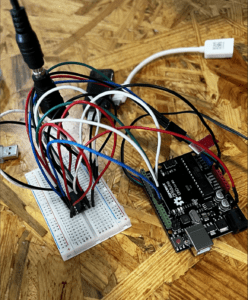Step 1: Build the Circuit
 In this recitation, I worked with my partner, Smile. Before we started with the task, we divided up the work where Smile took the task to build the circuit and I took the task to build the cardboard, and we helped each other when needed.
In this recitation, I worked with my partner, Smile. Before we started with the task, we divided up the work where Smile took the task to build the circuit and I took the task to build the cardboard, and we helped each other when needed.
The process of building circuit went smoothly for my partner, however when she tried to upload the code to the Arduino, the Arduino board is not detected. At last, we figured out that her Arduino board is not working, so all we have to do is to change it with a new board.
Step 2: Build a Cardboard Mechanism



To build a cardboard mechanism, first, I glued the template sheet onto the cardboard and cut out the parts using a ruler and a cutter. Then, I glued them together using a glue gun. I didn’t encounter any problem building the cardboard mechanism.
Step 3: Personalize it


My partner and I decided to personalize the cardboard mechanism into a cheer stick or the concert stick that fans of the singers or celebrities hold in their hands during the concert. We designed and decorated the concert stick with heart shapes and a pink highlighter. Once the mechanism is operated, the concert stick started moving front and back. It represents the cheering movement of a fan during the music concert.
Final Result:
Responses to Additional Questions
Question 1:
 The art installation, Kobito: Virtual Browines by Aoki Takafumi intrigued me the most while going over all of the installations mentioned in ART + Science NOW. The installation shows a mixed- reality world through a screen where there are creatures shown on the screen standing beside the actual objects in the real world. When people in the reality move the object, the creature in the virtual world can be affected, for example being knocked off by the object that was grabbed away by a person. Surprisingly, the creature within the virtual world can also manipulate the object in the real world (which is operated by the magnetic). It presented the linkage of the virtual world and the real world. This installation brought me back to my childhood dream of interacting with my favorite Disney characters in a similar way presented by Kobito. Comparing the installation with the work Smile and I did in this recitation, the installation involves interaction between the virtual world and the real world through the change in the environment, in contrary, our cardboard mechanism doesn’t involve much interaction and relation with the environment conditions. One similarity that I can think of is that both of the project have representations: Kobito represents the mixed-reality world or the linkage of two worlds, and our cupboard represents the concert stick waved by a fan for his/her idol. I think the artist used a small screen to display the virtual world, because it is hard to control objects using magnets displayed in a bigger screen representing a bigger environment with more things to consider.
The art installation, Kobito: Virtual Browines by Aoki Takafumi intrigued me the most while going over all of the installations mentioned in ART + Science NOW. The installation shows a mixed- reality world through a screen where there are creatures shown on the screen standing beside the actual objects in the real world. When people in the reality move the object, the creature in the virtual world can be affected, for example being knocked off by the object that was grabbed away by a person. Surprisingly, the creature within the virtual world can also manipulate the object in the real world (which is operated by the magnetic). It presented the linkage of the virtual world and the real world. This installation brought me back to my childhood dream of interacting with my favorite Disney characters in a similar way presented by Kobito. Comparing the installation with the work Smile and I did in this recitation, the installation involves interaction between the virtual world and the real world through the change in the environment, in contrary, our cardboard mechanism doesn’t involve much interaction and relation with the environment conditions. One similarity that I can think of is that both of the project have representations: Kobito represents the mixed-reality world or the linkage of two worlds, and our cupboard represents the concert stick waved by a fan for his/her idol. I think the artist used a small screen to display the virtual world, because it is hard to control objects using magnets displayed in a bigger screen representing a bigger environment with more things to consider.
Question 2:
I would be interested in building a mechanism into a game for my midterm project. In the project, there will be cardboard rats that will appear from the whole, and the player have to hit it with a mini gardena to make the rat go back into the hole. Materials such as bread board, Arduino Uno, jump wires, buzzer, stepper motors, force sensor, shaft adaptor, rivets, cutter, and a glue gun will be needed to build the project. Here, the motor and the stepper motor will work together to move the “rats” up and down the hole when the force sensor is hit by the mini gardena. If the concept of this project is presented using an animation on a digital screen instead of motors with a mechanism, the game will be a lot boring with the players only moving their fingers on the screen to play the game instead of larger physical movements.
